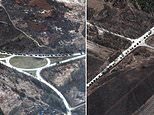Russian convoy stretching back 40 MILES advances on Kyiv
Russian convoy advancing on Kyiv now stretches for 40 MILES, satellite images show: Tanks and armored vehicles have reached outskirts of the Ukrainian capital
A convoy of Russian tanks and armored vehicles 40 miles long is currently advancing on KyivThe convoy left southern Belarus earlier on Monday and was initially believed to be 17 miles long, but the estimate has been revisedSatellite imagery from U.S. firm Maxar showed the scale of the deployment, with military vehicles stretching towards the Belarus borderHeavy shelling of Kyiv and Kharkiv, the second city, was taking place on Monday amid fierce resistance from Ukrainian forcesRussia on Monday deployed a horrific thermobaric bomb banned under the Geneva Convention, the Ukrainian ambassador to the U.S. said on MondayOksana Markarova, speaking after briefing Congressmen, claimed the Kremlin had used the devastating bomb during air strikes
<!–
<!–
<!–<!–
<!–
(function (src, d, tag){
var s = d.createElement(tag), prev = d.getElementsByTagName(tag)[0];
s.src = src;
prev.parentNode.insertBefore(s, prev);
}(“https://www.dailymail.co.uk/static/gunther/1.17.0/async_bundle–.js”, document, “script”));
<!–
DM.loadCSS(“https://www.dailymail.co.uk/static/gunther/gunther-2159/video_bundle–.css”);
<!–
A Russian military convoy traveling towards the Ukrainian capital of Kyiv has grown from being 17 miles long earlier on Monday to 40 miles, a satellite company has said.
Maxar Technologies, a private U.S. satellite company, also said additional ground forces deployments and ground attack helicopter units were seen in southern Belarus, less than 20 miles north of the Ukraine border.
Maxar said the convoy stretches from the Antonov airbase, 17 miles north of Kyiv’s city center, to just north of the Ukrainian town of Pribyrsk.
Pribyrsk is closer to the Ukraine-Belarus border and the failed nuclear reactor at Chernobyl than to Kyiv.
On Sunday, Maxar had measured the convoy — then near Ivankiv, Ukraine — at roughly 3.5 miles long.
A massive Russian military convoy is seen advancing from Belarus towards Kyiv
A 40-mile long convoy is seen traveling towards Kyiv on Monday
The head of the convoy is at Antonov airport, 17 miles from Kyiv city center
The line of vehicles is so extensive that it was not entirely captured in Monday’s satellite imagery.
In some areas, the vehicles are two to three rows deep.
It was not clear whether the convoy was all headed for the same final destination, or whether the military forces would split up and encircle the capital.
U.S. intelligence believes around 75 percent of Russian forces positioned on the borders with Ukraine are now inside the country.
Antonov airport, the closest Russian-held site to the center of Kyiv, was the scene of fierce fighting on Friday as it changed hands several times.
By Saturday, it was under Putin’s forces’ control.
Kyiv was subjected to a strong attack on Friday night and into Saturday morning, as Russian forces attempted to enter the city from all sides.
From the north, troops were attacking from Antonov airport, with a thermal power plant in the suburb of Troieshchyna the focus of fighting.
From the east, Putin’s forces advanced towards Kyiv zoo, sparking fierce battles along Peremohy Avenue – a main artery into the city.
And from the south, fighting was raging near the town of Vasilkov, 20 miles south of Kyiv.
On Monday, delegations representing Ukraine and Russia met in Belarus to discuss the future.
As soon as the discussions broke up, Russian forces began firing upon Kyiv.
Volodymyr Zelensky, the president of Ukraine, said on Monday night that his country had so far in the five-day conflict been hit with 56 Russian missile strikes, and 113 cruise missiles were fired.
He accused Russia of war crimes after Vladimir Putin’s forces launched what were believed to be cluster and vacuum bomb attacks on the fifth day of their invasion.
In a late night address directed at Russia, Zelensky said there would ‘definitely be an international tribunal’ for what he said was a ‘violation of all conventions’ and added that ‘no one in the world will forgive you for killing peaceful Ukrainian people.’
The chief prosecutor of the International Criminal Court said that he plans to open an investigation ‘as rapidly as possible’ into possible war crimes and crimes against humanity in Ukraine.
In the early hours of Tuesday, air raid sirens were sounding once again in the capital city.
Ukrainian media reported that the city of Kherson, 300 miles south of Kyiv on the Black Sea, was also coming under attack, Nexta reported.
Smoke can be seen near Ivankiv, 50 miles north of Kyiv, after the Russian convoy passed
A burnt-out car is seen in the east of Ukraine, in Donetsk, on Monday
The eastern city of Kharkiv, Ukraine’s second largest, came under heavy attack on Monday, killing nine civilians, The New York Times reported.
‘Today showed that this is not only a war, it is the murder of us, the Ukrainian people,’ said Kharkiv’s mayor, Igor Terekhov, in a video posted on Facebook.
‘This is the first time in its many-year history that the city of Kharkiv has been through something like this: shells that hit residential homes, killing and maiming innocent citizens.’
Terekhov said four people died on Monday when they emerged from bomb shelters to find water.
A family of five — two adults and three children — was burned alive when a shell hit their car.
Another 37 people were wounded, he said.
Ukraine’s ambassador to the U.S. claimed earlier on Monday that Russia used a devastating vacuum bomb on Ukraine.
Oksana Markarova, speaking after briefing members of the U.S. congress, said: ‘They used the vacuum bomb today, which is actually prohibited by the Geneva convention. The devastation that Russia is trying to inflict on Ukraine is large.’
The vacuum bombs, which are also known as thermobaric weapons, can vaporize bodies and crush internal organs. They use oxygen from the surrounding air to generate a high-temperature explosion, typically producing a blast wave of a significantly longer duration than that of a conventional explosive.
They are among the most powerful non-nuclear weapons ever developed.
![]()


